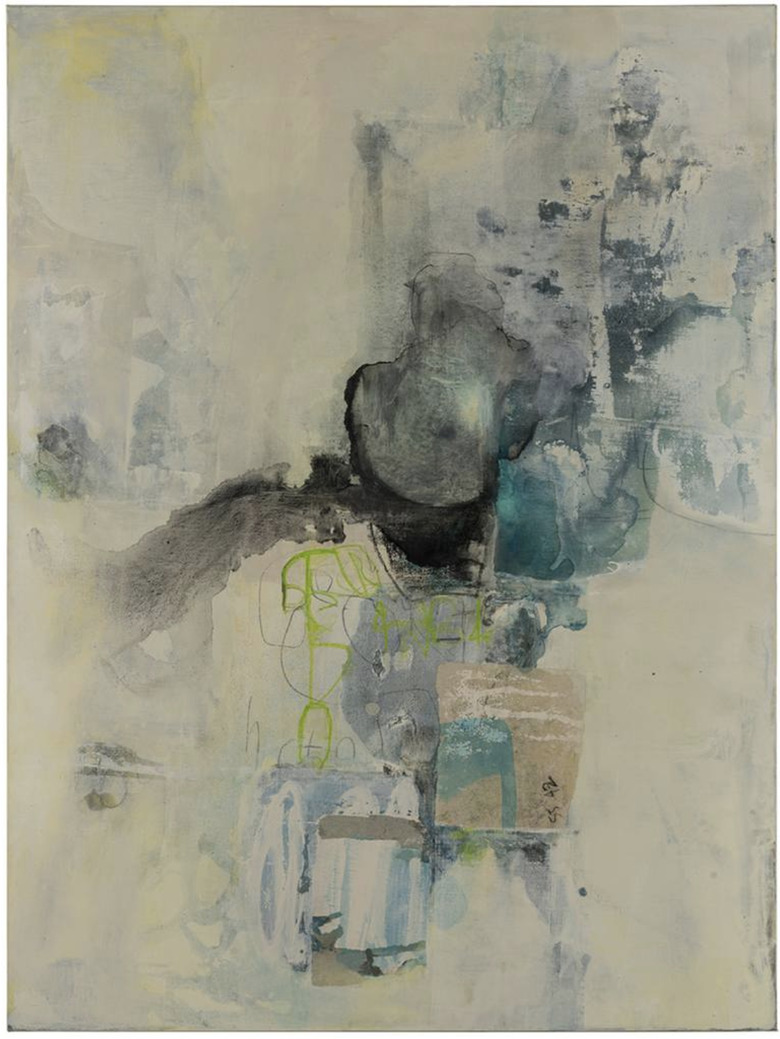In Conversation With Emily Van Horn, Featured Artist At Hunker House
Emily Van Horn didn't start painting until 2003 — but decades of work as a holistic healer helped set the stage for her success as an abstract painter.
"Painting," she says, "is my spiritual path."
Can you tell me a little bit about the pieces hanging at Hunker House?
There are three pieces — a diptych over the credenza and larger piece called Spirit Guide. I'm generally an abstract painter, but the interesting thing about this particular one is the face that was revealed to me. It becomes more noticeable in a photograph. It's a serene, meditative face with closed eyes. That was a nice little surprise — something I couldn't have done if I tried.
Was it subconscious?
Much of what I do is about the subconscious. I don't usually mention the face — it's like a hidden surprise that you might not notice.
I don't want to get too woo-woo, because the art world doesn't make room for that. I'm also a healer and that's what I've been doing for the last almost 30 years. These paintings are infused with ... I don't know what you want to call it ... light codes.
Interesting. What are light codes?
Let's just call it energy. Everything is energy, right? I understand it as embedded bits of information that may activate something inside someone and cause an energetic shift. It's more than just a pretty thing that hangs on the wall.
How are they representative of your work?
There are a variety of ways in which I like to work.
Timeline Shift and Waiting for a Sign are more representative of what I would call flow or stain paintings.
A more organic approach, almost like a meditation. Working mostly on the floor and pouring the paint onto a wet surface — sometimes letting it spread where it wants to go, sometimes interfering with the marks that are forming.
The other work is created on the wall with brushes and tools and sometimes adding collage and drawing elements.
Painting is your second career. How did that come about?
I'd always been around artists and art but lacked the confidence to try. I didn't think I'd be any good at it. There was a moment when I just needed to change things up. I was going through a difficult breakup. I needed to get out of the house and focus on something that wasn't too challenging. I found a collage class at Santa Monica City College.
I even joked to myself, Collage, you need a class for that? Don't you just glue scraps cut out of a magazine? But I really, really liked it. The same lady taught color theory as well, so I took that. Next, I went to the Esalen Institute and did a month-long workshop called Vision Painting. It wasn't about technique, just expressive. I didn't know what I was doing at all, but I knew that I really wanted to continue.
Back in Los Angeles, I decided to find a teacher. I studied with Ilana Bloch, who was a great mentor. It wasn't my intention to become a career artist — it just happened.
It all sounds really organic.
It wasn't like I went to art school. I didn't have a fancy background. I never thought I could do anything like that. I got lucky with a good teacher and people started buying my work. It's addicting when someone buys your work. It's a good feeling. It's like a deeper form of communication — someone understands your language.
How does one career inform the other?
I believe that through personal evolution as healer and someone who is always working my own inner evolution, it's just resonance that we incorporate. It seeps into whatever you're doing. In my case, there's something beyond what I'm aware of that's [influencing] the colors and forms, that are somehow going to be transformative to the people who receive it.
I believe every piece is meant for someone in particular. It's like a recipe for them, or a prescription. A clairvoyant who visited my studio once told me — this was during the Venice Art Walk — Oh, when someone has this painting, it's like they're having 20 sessions with you. I thought, Oh, really? It's one thing to hear it once, but then I've since then had other confirmations. People have had experiences with the work where they have been moved, uplifted.
They are having an effect on me as well. I'm activating the canvas and the canvas activates me. It's goes back and forth. It's my job to follow the breadcrumb trail. I may set out with something in mind, a color palette or form, but that's just a starting point.
You don't have a destination.
No, and that can be challenging or frustrating even. If you know what you're trying to paint, you know when you get there, you know how to construct it. When you're following this internal-external conversation, you have to have patience and faith. Sometimes it can take a long time to resolve.
Can you tell me a little bit about your studio? I see an incredible bed frame.
I was forced out of my Venice studio about a year ago. Everything was up in the air, I didn't know what to do. I was overwhelmed.
Not wanting to commute to downtown, I looked for a place in Topanga Canyon and got lucky. Now I spend half the week in Topanga and the other half in Venice.
It's my first live/work space. Everything is in one room, with a main wall that I use to paint on. I have a beautiful view on a really lovely property called Eden Ranch.
What is it like, living amongst your paintings?
I've always wanted that, to wake up and be in the environment and not have to go anywhere.















